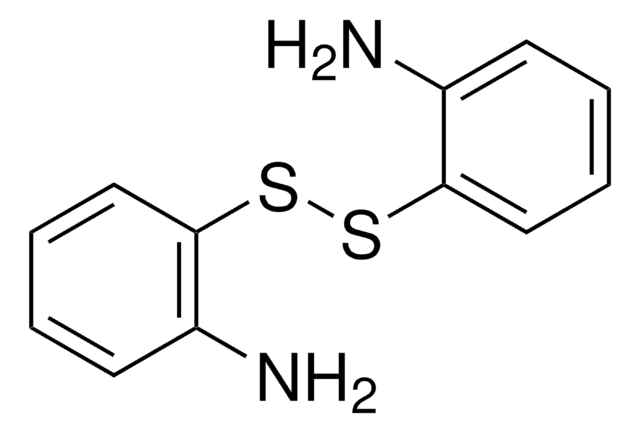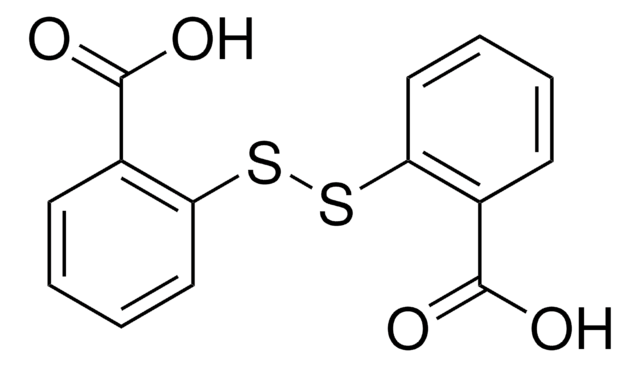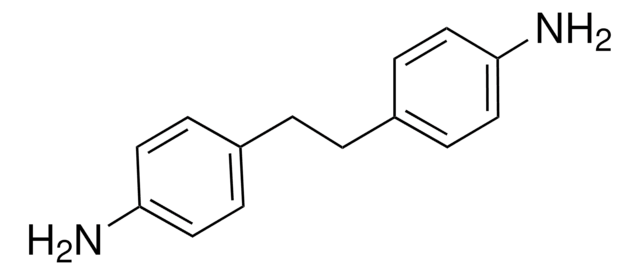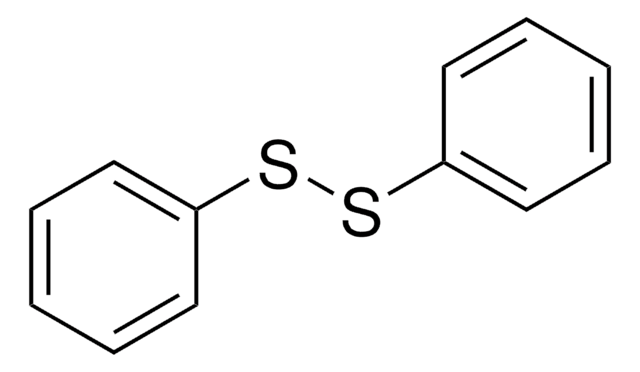Wszystkie zdjęcia(1)
Kluczowe dokumenty
369462
4-Aminophenyl disulfide
98%
Synonim(y):
4,4′-Dithiodianiline
Zaloguj sięWyświetlanie cen organizacyjnych i kontraktowych
About This Item
Wzór liniowy:
(H2NC6H4S-)2
Numer CAS:
Masa cząsteczkowa:
248.37
Numer WE:
Numer MDL:
Kod UNSPSC:
12162002
Identyfikator substancji w PubChem:
NACRES:
NA.23
Polecane produkty
Poziom jakości
Próba
98%
Postać
powder
mp
77-78 °C (lit.)
ciąg SMILES
Nc1ccc(SSc2ccc(N)cc2)cc1
InChI
1S/C12H12N2S2/c13-9-1-5-11(6-2-9)15-16-12-7-3-10(14)4-8-12/h1-8H,13-14H2
Klucz InChI
MERLDGDYUMSLAY-UHFFFAOYSA-N
Szukasz podobnych produktów? Odwiedź Przewodnik dotyczący porównywania produktów
Powiązane kategorie
Opis ogólny
4-Aminophenyl disulfide is primarily used as a reagent in chemical synthesis. It has thiol-disulfide interchange properties, making it useful in redox reactions and the synthesis of polymers. It can participate in thiol-disulfide exchange reactions, facilitating the formation of covalent bonds with other thiols or disulfides. 4-Aminophenyl disulfide is often employed as a crosslinking agent, particularly in polymerization reactions, where it can enhance the mechanical and thermal properties of polymers. It can also act as a dopant or charge-transfer agent in conductive polymers, improving their electrical conductivity.
Zastosowanie
4-Aminophenyl disulfide can be used as:
Bioconjugation: The amine group can react with carboxylic acids or their derivatives, making it useful for conjugating biomolecules like proteins and peptides. This is particularly valuable in developing targeted drug delivery systems where the drug is directly linked to a molecule that can home in on cancer cells or other disease sites.
Diagnostic Agents: It can be used to modify surfaces of diagnostic devices, such as biosensors. They can help in the immobilization of biomolecules on sensor surfaces, improving the sensitivity and specificity of detection.
- A crosslinker in the synthesis of self-healing poly(urea-urethane) elastomers because of its quantitative healing efficiency. These self-healing materials find applications in various fields such as drug delivery, wound healing, and tissue engineering, electronics, aerospace, and coatings.
- A hardener in the formulation of re-processable, repairable, and recyclable epoxy networks due to the presence of dynamic disulfide bonds, which enable the epoxy networks to undergo chemical recycling. These epoxy networks are widely used in various applications which include, composite materials, coatings, adhesives, and fiber-reinforced thermoset composites.
- A crosslinking agent for the development of epoxy vitrimers and carbon fiber composites with enhanced mechanical properties, multi-shape memory capabilities for the potential applications in high-performance materials.
Bioconjugation: The amine group can react with carboxylic acids or their derivatives, making it useful for conjugating biomolecules like proteins and peptides. This is particularly valuable in developing targeted drug delivery systems where the drug is directly linked to a molecule that can home in on cancer cells or other disease sites.
Diagnostic Agents: It can be used to modify surfaces of diagnostic devices, such as biosensors. They can help in the immobilization of biomolecules on sensor surfaces, improving the sensitivity and specificity of detection.
Ta strona może zawierać tekst przetłumaczony maszynowo.
Kod klasy składowania
11 - Combustible Solids
Klasa zagrożenia wodnego (WGK)
WGK 2
Temperatura zapłonu (°F)
Not applicable
Temperatura zapłonu (°C)
Not applicable
Środki ochrony indywidualnej
dust mask type N95 (US), Eyeshields, Gloves
Wybierz jedną z najnowszych wersji:
Masz już ten produkt?
Dokumenty związane z niedawno zakupionymi produktami zostały zamieszczone w Bibliotece dokumentów.
Klienci oglądali również te produkty
C Domenget et al.
Biochimica et biophysica acta, 830(1), 71-79 (1985-07-18)
The effects of four thiol reagents on the kinetics of polymerization of hemoglobin S have been studied in high phosphate buffer (1.8 M), in the presence (3 mM) or absence of sodium dithionite, depending on the reduction of mixed disulfides
Martin L Henriksen et al.
ChemSusChem, 10(14), 2936-2944 (2017-05-31)
Epoxy-based thermosets are one of the most popular matrix materials in many industries, and significant environmental benefits can be obtained by developing a recyclable variant of this widely utilized material. Incorporation of a bio-based disulfide additive within a commercial epoxy
Y Maede et al.
Blood, 73(1), 312-317 (1989-01-01)
It has been shown that certain dogs have erythrocytes characterized by an inherited high concentration of reduced glutathione (GSH), five to seven times the normal level (high-GSH RBCs). We examined whether increased GSH in dog erythrocytes leads to increased protection
Nasz zespół naukowców ma doświadczenie we wszystkich obszarach badań, w tym w naukach przyrodniczych, materiałoznawstwie, syntezie chemicznej, chromatografii, analityce i wielu innych dziedzinach.
Skontaktuj się z zespołem ds. pomocy technicznej











